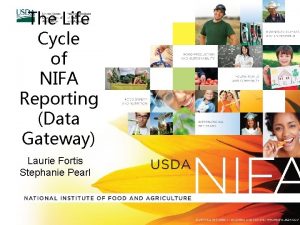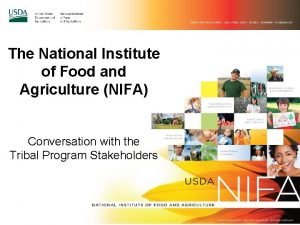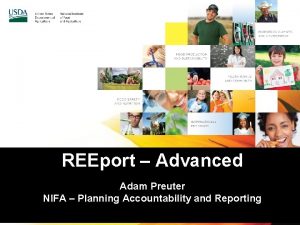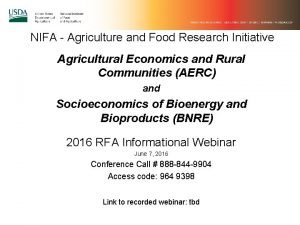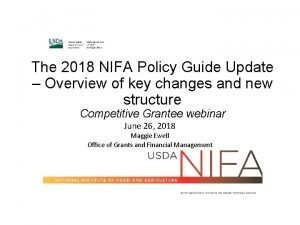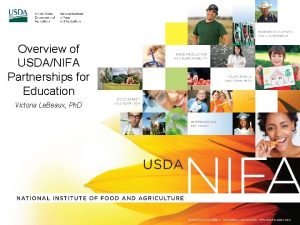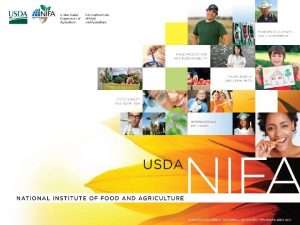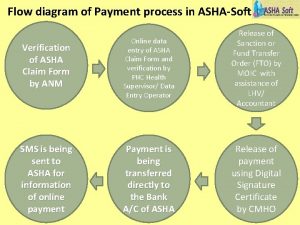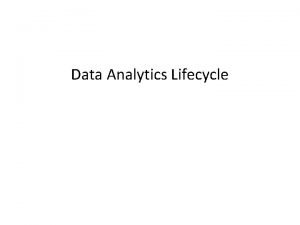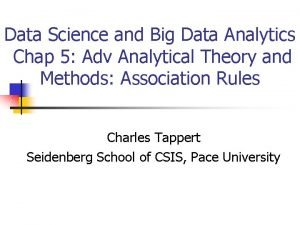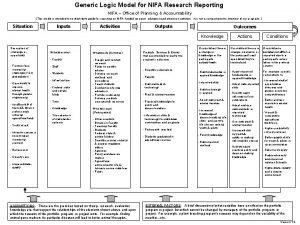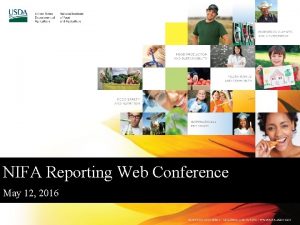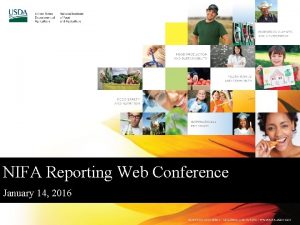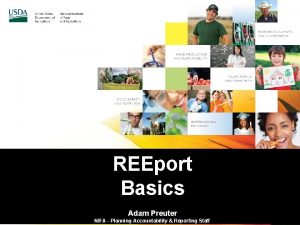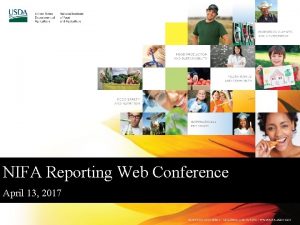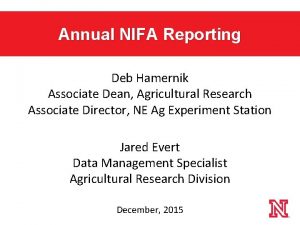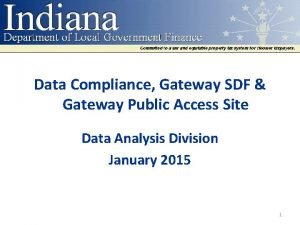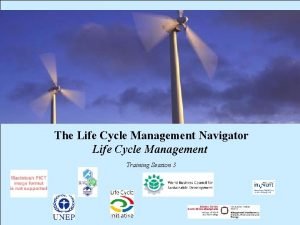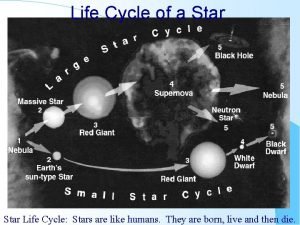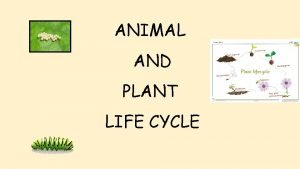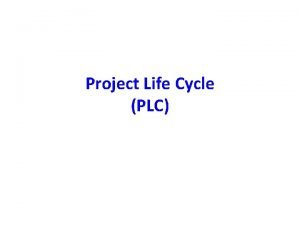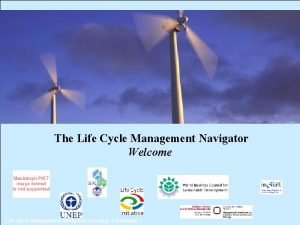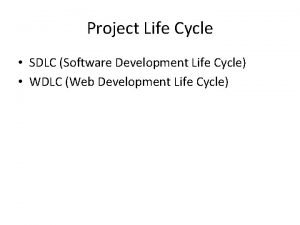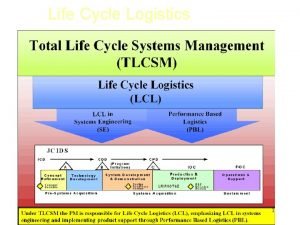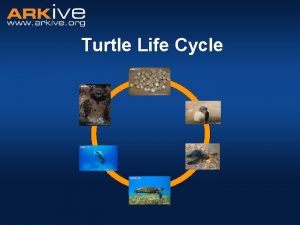The Life Cycle of NIFA Reporting Data Gateway















































- Slides: 47

The Life Cycle of NIFA Reporting (Data Gateway) Laurie Fortis Stephanie Pearl

Objectives 1) Describe why your reporting matters to various audiences 2) Understand who uses your reporting data for what purposes 3) Effectively classify your projects and understand why it matters to do so 4) Conduct project searches in NIFA’s Data Gateway 5) Effectively initiate and report on your projects 6) Understand NIFA’s communications channels for publicizing your work

Part I: Your reporting matters!

Why report outcomes and impacts? Congress cares about your outcomes and impacts! https: //www. youtube. com/watch? v=f. Oh. Dc. UY 7 GA&feature=youtu. be&t=3 h 35 m 32 s

Why Does NIFA Report? NIFA Mission: Invest in and advance agricultural research, education, and extension to solve societal challenges. Your Results = Our Success! • • • Quantitative and Qualitative Commercialization Solutions Steps Toward Breakthroughs Your Stories Data Gateway

Who cares about your research? How do we share this information?

How Does NIFA Use Your Results: • • Funding of topic areas for annual reports to Congress Funding by Program Funding by State Funding by Institution Evaluations Success Stories/Vignettes Portfolios

Qualitative Data • Project Title, Objectives, Non-technical Summary, Outputs, and Collaborators from Project Initiation • Accomplishments and Products in Progress and Final Reports • Annual Reports (Plan of Work) • Classifications

Quantitative Data • Number of Projects • Amount of Funding (Competitive and Non. Competitive Grants; and Expenditures) reported separately via percentages applied to the CRIS Classifications chosen for a project. • Number of Students, Staff, and Scientists (jobs/pipeline) via CIP codes and FTEs • Number of Patents or PVPs (Commercialization) • Number with Behavior Change (Plan of Work)

Part II: How you classify your projects matters – a lot! Project classifications affect how we find and use your data. Let’s discuss best practices.

Bioeconomy -Bioenergy. Bioproducts Portfolio: CRIS Classifications: Non-Food KA 511 Products & Processes KA 512 Storing & Marketing

Why Do Classifications Matter? Knowledge Area (KA) Topic Area: Food and non-food products: development, processing, quality, and delivery KA 511 Non-Food Products & Processes KA 512 Non-Food Storing & Marketing Subject of Investigation (SOI) SOI 2355 Perennial Grasses Field of Science (FOS) FOS 1080 Breeding 25% of Accession No. 1010000

What’s in a Word? • When CRIS Classifications Fall Short to Represent the Topic • Used to supplement searches for other topics not included in the CRIS Classifications including Crosscuts • Used to “tag” projects by NIFA Staff • Keywords or terms might include: Bioenergy, “Renewable Resources”, Bioproducts, Coproducts, “Anaerobic Digest*”

How do we use Award Information? Grant Management System: Competitive Awards = NIFA Obligations to Recipient Institutions Award Information includes: FYXX – FDCXX - XXXXX • Fiscal Year Awarded • Funding Information and Program Information using the Financial Data Code (FDC) Classifications Portfolios (Topic Areas)

Summary of What We Do: • Classifications determine the Portfolio, which are used to measure the performance of our programs. Terms supplement classifications. • Objectives and Progress/Accomplishments/ Outcomes for evaluation of program success. • REEport Financial Reports are used to report Capacity funding and jobs • Other key fields also support success stories • Key project information can allow us to find associated projects by funding line or topic

Part III: Searching for projects in NIFA’s Data Gateway Classifications put to work: How NIFA, you, and the public can find progress reports of NIFA-funded research nifa. usda. gov/data

How Can You Search for Specific Projects? *Accession Number: 1 XXXXXX Project Number: Your Number Multistate Project Number Award Number: 2016 -33610 -12345 Program Code: i. e. A 3101 Expand the box to see pre-selected (default) search fields when entering terms *Project Director: (Last Name, First Name or initial) nifa. usda. gov/data

How Can You Find Projects by Topic? To find multiple projects at once (topics): Use terms and “Search in these fields” boxes: Initiation Reports: Keywords, Methods, Objectives, Non-Technical Summary, Project Title, or Recipient City Name for specific locations Progress Reports: Accomplishments, Patent Title, Progress, Publications To see all the projects that have Progress, Publications, Accomplishments, or Patent Titles - uncheck all the other fields in the “Search in these fields…” box. Then refine your results by Filtering: Sponsoring Agency, State, Recipient Institution, Years, Program Area, Classifications, FDC, or Funding Source nifa. usda. gov/data

How To Use Filters to Find Projects? 1. Search Classifications for: • • • Overall Topics: Knowledge Areas Subject: Subject of Investigation Scientific Discipline: Field of Science 2. Narrow down projects by: You can now multi-select, and search within filters Sponsoring Agency, Financial Data Code (FDC), Project Status, Recipient Organization, and/or Recipient State • Look for grants by: Initial Award Year, Award Amount Range or Program Area • Look for capacity projects by: Funding Source • Look for capacity and grant projects by: Progress: Report Fiscal Year

Assisted Searching: Project Details For searching using one or more Classifications, Program Areas, Projects, or a set of projects for a particular Program, State, Institution, or Topic Search by Keyword or Phrase using ‘terms’ search box: Enclose phrases in quotes i. e. “Climate Change” Use AND, OR, NOT joiners between terms Use * as a wildcard character Includes Project Initiation and Progress fields under the “Show these fields in the results…” box. You can now multi-select filter values, or start to type the value in the filter search box to select values under filters nifa. usda. gov/data

Two Ways to View Results: 1. Document View accommodates large text or multiple entry text fields in Progress Reports including the Progress Details fields and Project CRIS Classifications 2. Tabular View (Default) – similar to Financial Details nifa. usda. gov/data


When to Use Financial Details The only source of funding information for Formula/Capacity projects, available for export. When you only need information from the REEport Financial Report for the projects you are reporting on. Can still search by project using all the same identifiers with the addition of Department. Note that, in order to view funding in this search, weighted by Classification topics, you need to choose the Project Classifications field in the “Show these fields in the results…” box and click search. nifa. usda. gov/data

When to Use Advanced Search • Replaces the CRIS Professional Search • Best when using multiple values for multiple fields, ranges, or excluding specific values in a search. • Use for longer searchers where dependent or nested criteria are needed to isolate the projects you need. • These are the same fields as Project Details, but with additional search functionality. See the Data Gateway Resource Page for a full list of data elements and the values available. nifa. usda. gov/data


Part IV: What makes for a good progress report? Tips on how to effectively write about planned and past project progress

Project Initiation REEport – Project Initiation

Project Initiation • Goals – Goal: broad statement of your project’s purpose – Corresponding objectives: specific, measurable, attainable actions required for achieving goal • Methods – Efforts: experiments, analyses, focus groups, instruction, workshops, outreach – Evaluation: How will you assess whether your milestones and objectives have been met Most of this information already exists in your project proposal You will refer to these each year when you complete your progress report

Project Initiation: Outcomes In what ways do you anticipate your project will effect change? 1) Change in Knowledge: Occurs when a participant (scientist, trainee, citizen, etc. ) learns or becomes aware. 2) Change in Action: Occurs when there is a change in behavior or the Most of this information already exists in your project proposal participants act upon what they have learned You will refer to these each year when you complete your (adoption of techniques and methods or a change in progress report practice). 3) Change in Condition: Occurs when a societal condition is changed due to a participant's action.

Project Initiation: Non-technical summary • Arguably the most important section of your report!! • This is your opportunity to clarify the importance of your project in non-technical terms that people without scientific backgrounds can understand • This is the part that will be accessed by legislators who make decisions about funding allocations, general public, community leaders, and taxpayers

Non-technical summaries are prominently displayed at the top of your public-facing progress report

Project Initiation: Non-technical summary 1) What is the context of your project? What is the problem you are addressing and why does it matter? (Address the “so what? ” of your work. ) 2) How will you approach these issues? Brief, non-technical description of your methods 3) What do you hope to accomplish through your work? Anticipated outcomes/impacts 4) Why is this work important? How will your anticipated outcomes relate to the broader context? How will your results affect the broad context of your project? (Consider your goals here. )

Progress Report

Progress Report: Products • Publications • Patents and Plant Variety Protections

Progress Report: Other Products • Activities: datasets produced, analyses conducted, assessments Don’t simply • Events: conferences, workshops, trainings, symposia list – include context • Services: consulting, counseling, tutoring • Other products: multimedia, germplasm, software, maps, new techniques, students graduated What outputs did you generate to fulfill your objectives?

Progress Report: Accomplishments This is where you describe your progress toward accomplishing your goals and anticipated outcomes Ask yourself: What do your results suggest so far?

Accomplishments are publicly displayed as impacts

Progress Report: Accomplishments 1) Describe the general context of your work Issue -Restate the relevant portion of the context you described in your non-technical summary in the project initiation -Restate the relevant goals 2) For each objective addressed in the given reporting year, describe a. The work you conducted What’s a. General description of your methods (non-technical) b. Results (with quantitative and qualitative indicators, as been appropriate) done b. Realized anticipated outcomes a. What changes in knowledge, action, or behavior have you seen thus far? Results b. Based on your results, what changes in knowledge, action, or behavior do you anticipate?

Helpful Hints • Write for the audience (Congress, NIFA) – Why is the project important to constituents? – What result do you want to achieve through communicating your impact? • Avoid: – Jargon – Acronyms – Passive voice

Part V: How does NIFA tell your story? Overview of NIFA’s communications efforts

Measurement Communications Purpose Meet legislative requirements for Highlight the best examples data-driven decision making Relate to public value Demonstrate public value Products Report against strategic and program goals Performance-based (outcome measures) Cost-Benefit analyses NIFA Annual Report NIFA Website and Brochures “Impact” Statements Qualities Rigorous and comprehensive Independent and objective Meet standards of evidence Required Anecdotal Biased due to self-selection Deliberate story-telling Feel-good human stories Requested Methodology Quantitative and Qualitative (mixed methods) Done over time with deliberate planning Typically qualitative Done quickly (on demand) 41

NIFA’s outreach channels • Success stories in “Fresh from the Field” • Press releases • Graphical handouts • Social media • Annual reports • Budget justification These are all available on the NIFA website and distributed via email distribution lists bit. ly/NIFAsubscribe

Measurement Communications Purpose Meet legislative requirements for Highlight the best examples data-driven decision making Relate to public value Demonstrate public value Products Report against strategic and program goals Performance-based (outcome measures) Cost-Benefit analyses NIFA Annual Report NIFA Website, Brochures, and Social Media “Impact” Statements Qualities Rigorous and comprehensive Independent and objective Meet standards of evidence Required Anecdotal Biased due to self-selection Deliberate story-telling Feel-good human stories Requested Methodology Quantitative and Qualitative (mixed methods) Done over time with deliberate planning Typically qualitative Done quickly (on demand) 43

How does NIFA decide what to communicate? • Topics of Congressional interest – Examples: Citrus greening, precision ag • Major advancements in the field • Possess a “wow!” factor • Timely items within the scope of the news cycle – Examples: Food safety at Thanksgiving, Water or drought research on World Water Day, Veterans Stories on Veterans Day • Compelling stories of how NIFA-funded projects affect individuals’ lives Projects with well-written progress reports are more likely to be communicated bit. ly/NIFAsubscribe

Share Your Science at any time of the year! What to communicate • Manuscript publication in a major journal • Photos, videos, press releases, other publicity of your work • Updates on major accomplishments How to communicate it • Email your NPL directly • Email Impact. Stories@nifa. usda. gov • Twitter: @USDA_NIFA #NIFAimpacts Seek assistance from your university’s public affairs office


Take-home messages • We really do read and use your progress reports! • Your progress reports are publicly displayed • Accurate, high-quality reporting affects our ability to measure the impact of our programs and show the societal value of our programs to legislators
 Usda nifa
Usda nifa Nifa ewd rfa
Nifa ewd rfa Usda nifa
Usda nifa Nifa in economics
Nifa in economics Nifa policy guide
Nifa policy guide Usda hec grant
Usda hec grant Usda nifa
Usda nifa Payment process flow
Payment process flow Predictive analytics life cycle
Predictive analytics life cycle Discovery phase in data analytics
Discovery phase in data analytics Big data analytics life cycle
Big data analytics life cycle Hát kết hợp bộ gõ cơ thể
Hát kết hợp bộ gõ cơ thể Ng-html
Ng-html Bổ thể
Bổ thể Tỉ lệ cơ thể trẻ em
Tỉ lệ cơ thể trẻ em Gấu đi như thế nào
Gấu đi như thế nào Tư thế worm breton
Tư thế worm breton Hát lên người ơi
Hát lên người ơi Các môn thể thao bắt đầu bằng từ đua
Các môn thể thao bắt đầu bằng từ đua Thế nào là hệ số cao nhất
Thế nào là hệ số cao nhất Các châu lục và đại dương trên thế giới
Các châu lục và đại dương trên thế giới Cong thức tính động năng
Cong thức tính động năng Trời xanh đây là của chúng ta thể thơ
Trời xanh đây là của chúng ta thể thơ Cách giải mật thư tọa độ
Cách giải mật thư tọa độ 101012 bằng
101012 bằng Phản ứng thế ankan
Phản ứng thế ankan Các châu lục và đại dương trên thế giới
Các châu lục và đại dương trên thế giới Thể thơ truyền thống
Thể thơ truyền thống Quá trình desamine hóa có thể tạo ra
Quá trình desamine hóa có thể tạo ra Một số thể thơ truyền thống
Một số thể thơ truyền thống Cái miệng bé xinh thế chỉ nói điều hay thôi
Cái miệng bé xinh thế chỉ nói điều hay thôi Vẽ hình chiếu vuông góc của vật thể sau
Vẽ hình chiếu vuông góc của vật thể sau Biện pháp chống mỏi cơ
Biện pháp chống mỏi cơ đặc điểm cơ thể của người tối cổ
đặc điểm cơ thể của người tối cổ Ví dụ giọng cùng tên
Ví dụ giọng cùng tên Vẽ hình chiếu đứng bằng cạnh của vật thể
Vẽ hình chiếu đứng bằng cạnh của vật thể Tia chieu sa te
Tia chieu sa te Thẻ vin
Thẻ vin đại từ thay thế
đại từ thay thế điện thế nghỉ
điện thế nghỉ Tư thế ngồi viết
Tư thế ngồi viết Diễn thế sinh thái là
Diễn thế sinh thái là Các loại đột biến cấu trúc nhiễm sắc thể
Các loại đột biến cấu trúc nhiễm sắc thể Số nguyên là gì
Số nguyên là gì Tư thế ngồi viết
Tư thế ngồi viết Lời thề hippocrates
Lời thề hippocrates Thiếu nhi thế giới liên hoan
Thiếu nhi thế giới liên hoan ưu thế lai là gì
ưu thế lai là gì
